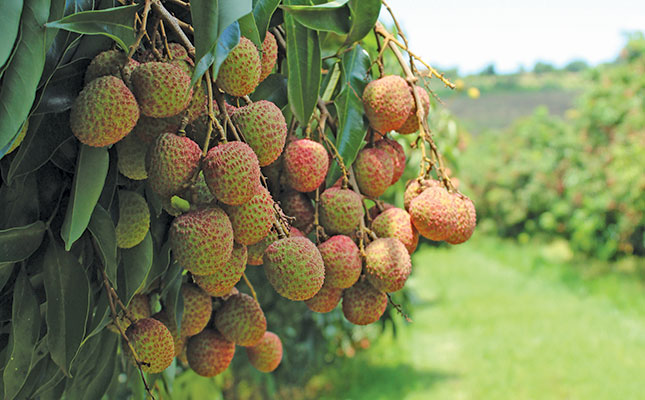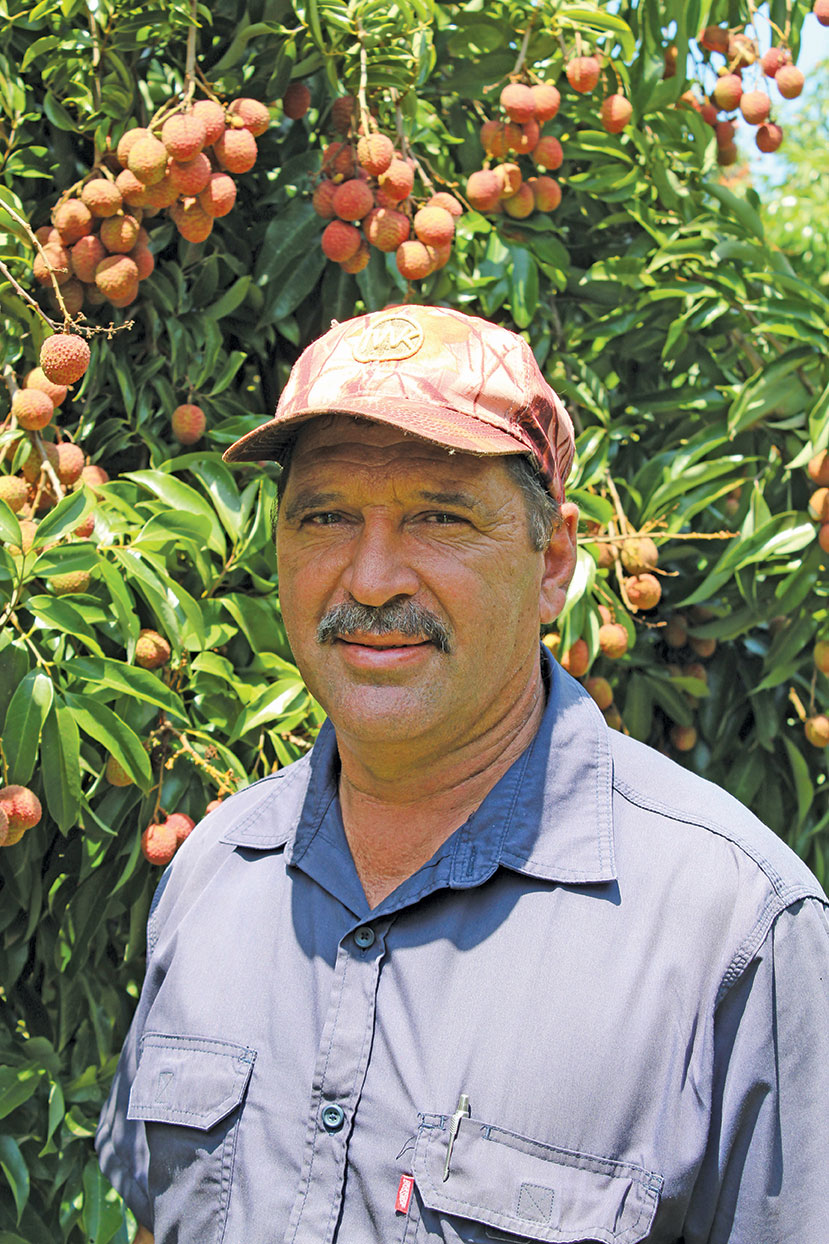
Photo: Lindi Botha
The subtropical hills and valleys of Hazyview in Mpumalanga were once home to numerous litchi producers. But the difficulties of having to harvest in December, when labour is scarce and prices are low due to market oversupply, saw farmers increasingly replacing the crop with others.
A favourite alternative, thanks to their constantly rising prices, has been macadamias.
These challenges have not deterred litchi producer Pieter Luus, however. Although he has also ventured into macadamia production, his 10ha of 18-year-old Mauritius litchis are still very much part of the farm’s success.

Luus notes that litchi trees remain productive for 50 years, depending on how well they are looked after. So he pays close attention to this aspect, in particular maintaining a robust pruning regime.
Pruning for yield
Since litchi trees produce fruit only on new branches, they have to be pruned both for production and to keep them at an optimal size.
“The trees must be maintained in an umbrella shape, with light able to penetrate the middle of the tree,” explains Luus. “Litchi trees grow very quickly, and windows for sunlight must be cut regularly to ensure that the tree doesn’t die off on the inside.”
Pruning needs to take place as soon as possible; in fact, it forms part of the harvesting process, with bearing branches being broken off as the litchis are picked. After harvest, the workers perform another round of branch removal, taking care not to remove more than a third of the tree’s branches or the following year’s yield will be negatively affected.
Branches are removed to prevent the tree from producing excessive wood.
“A litchi tree bears fruit only on new branches. So to ensure it doesn’t keep getting bigger and bigger, producing litchis only on its outer branches, we break off old branches, and the crop then grows on the new branches that appear,” explains Luus.
“Every three or four years we do a drastic prune, using electric cutters, to get the trees back to a manageable size. The yield takes a bit of a knock that year, but it’s better in the long run, as the tree then has the right shape and can be hand-pruned thereafter.
“Keeping the trees shorter also makes harvesting far easier. We aim for around 5m in height, but if they’re on a slope, they can be more difficult to reach, so we keep them even shorter here.”
Optimal fertilisation
Luus says that getting the fertiliser programme right and timing the applications correctly make all the difference to yield. Some nutrients are especially time-sensitive.
He has adjusted his fertiliser regime over the years, paying close attention to the timing of nitrogen applications.
“Previously, we applied nitrogen just after pruning in January, but this produced excessive growth. Now we wait until June to apply nitrogen. This provides the tree with enough energy to see it through winter. At this stage, the tree doesn’t have enough energy to produce excessive wood, so the extra nitrogen just gives it a boost through the cold months. We apply nitrogen at a rate of 90kg/ha in June and July.”
This is followed up with a phosphate application of 2kg/ha in October and between 65kg/ ha and 140kg/ ha of potassium, depending on the results of soil and leaf analyses. Low potassium levels can cause the fruit to burst, especially when it is exposed to high temperatures for long periods.
Luus says that boron also plays an important role in litchi nutrition and he applies 5kg/ ha annually, spread across four doses.
“Other micro-elements are applied as foliar sprays according to leaf analysis. This is done around August when flowering starts.”
Keeping the pH of the soil at the correct level of 5,5 is of particular concern to Luus. As his soil averages 6,8, he applies calcitic lime at a rate of 1,2t/ha to 1,3t/ha each year.
He also applies extra compost, consisting of composted macadamia nut husks and cattle manure, to increase the organic matter in the soil. This is done at a rate of 8kg/tree/year.
Soil, irrigation and pollination
Luus admits he has a dislike of bare soil, and has planted grass between the rows of litchi trees.
“It aids moisture retention and soil conservation. We slash the grass under the trees when we start harvesting to make it easier to get into the orchards. The grass between the rows is cut and [the cuttings] are placed under the trees.”
The soil in the orchards varies, but consists mainly of sand and sandy loam. Luus uses tensiometers to determine irrigation periods, and generally applies about 20mm of water/week.
“The timing of the irrigation is important and it’s also necessary to apply water across the rows and not just under the trees. Litchis do best when all of their roots are irrigated.
“Some farmers believe in limiting water at certain times to put the tree under stress and hence induce flowering. I don’t follow this practice; I prefer applying water throughout. We’re already quite marginal, so I don’t want to stress the trees further.”
Pollination is carried out via bee pollination services, which up until now have been provided at no cost. “Litchi honey has always been in high demand, but now that macadamia farmers are paying for pollination services, the companies have indicated that they will start charging us in future too.”
Despite this extra cost, Luus says that litchis have few inputs compared with most other crops.
“I don’t do any chemical applications and fertiliser inputs are fairly low. This means that despite litchis not achieving huge prices on the market, it’s still a profitable crop.”
Holiday harvest
The timing of the litchi harvest is a challenge to all litchi farmers, as labour is scare at this time of the year. Luus starts harvesting on about 16 December, and usually ends during the second week of January. The yield varies from year to year, with an average of 8t/ha marketable fruit.
About 60 labourers are employed for the harvest. In addition to professional workers, Luus employs students who want to earn a holiday income.
“I foresee that in future we’ll need to use a labour contractor to source labour for us. This will make the harvest more expensive, but it seems to be the only way forward,” he says.
Litchis are said to be alternate-bearing, but Luus has found that with careful management, a more evenly balanced yield can be obtained from year to year.
“The trees produce a flush as soon as they’re pruned. Spraying ethephon after pruning stops the vegetative growth and forces the tree to start producing flowers instead. It holds the tree back a bit, but ensures a more even yield.”
As mentioned, Luus has found litchi and macadamia production to be a useful combination at this stage on his farm.
“Our macadamias are not yet fully in production and the litchis make a big contribution to my cash flow,” he says. “It also ensures an income during December, which means I can pay bills in January. I’ve been able to put my children through school and partly through university with the income from the litchis. But it’s hard work, most of which takes place while everyone else is on holiday!”
Oversupply and low prices
Another challenge of litchis is that the harvest must be started and completed within the four-week December-January period.
“The market is effectively flooded for a short time and prices are low. Prices also depend on how much volume Komatipoort’s litchi producers send to the market, and when. We can’t compete with them.
“Even though litchi farmers are dwindling, the reduced supply doesn’t seem to influence farmers’ prices. I’ve found that sending fruit to municipal markets in particular is a problem, as everyone’s fruit arrives at the same time. So I sell most of my litchis to local hawkers and private buyers from KwaZulu-Natal, as prices are higher. I’m also ensured of income and am paid immediately.”
Unfortunately, the value of the litchis is still high enough to keep thieves active. When the fruit starts ripening, Luus employs security to patrol the orchards at night.
Despite these challenges, input costs are a fraction of those of avocado and macadamia production. Pest control, for example, is minimal.
“I don’t need to apply any chemicals for pests, as fruit flies are controlled with fly traps and pheromones, and litchis have very few pests, anyway.”
All things considered, Luus has no intention of replacing the litchis with another crop over the next few years.
“At least not until I know that macadamias can replace that income.”
Email Pieter Luus at [email protected].










